Pagination - DevNatan/inventory-framework GitHub Wiki
Pagination is a state-component that allows you to display a large amount of data in an view by separating it into pages.
- Creating Pagination
- Behaviors
- Asynchronous Pagination
- Pagination + Layouts
- Diving into Pagination
- Navigation
- Handling Page Switch
- Multiple Paginations
To create a pagination you have two essential parameters:
-
sourceProviderto define the pagination data e.g.: a list of names. -
elementFactoryto create the items that will be displayed to the player in the view for each paginated element e.g.: a head of a player.
Use paginationState to create a new static pagination.
(There are other types of pagination that will be explained later)
final State<Pagination> paginationState = paginationState(sourceProvider, elementFactory);In the example below, our pagination data is a list of player names: Notch, Natan and Michael.
The list of players name is provided by the sourceProvider parameter and for each name we will display a player head item is provided by the elementFactory parameter.
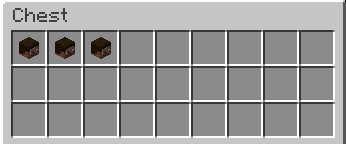
final State<Pagination> paginationState = paginationState(
Arrays.asList("Notch", "Natan", "Michael"),
[...]
);In the elementFactory parameter you have access to everything you has: the current context to get access like ctx.getPlayer(); a builder to construct the item instance; the current pagination index of the element being paginated; the value which is the element being paginated, in the case below it is the player's name.
Builder allows you to use everything we learned earlier in Basic Usage page.
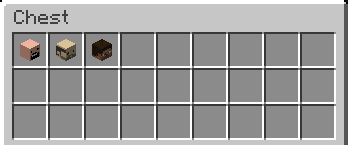
final State<Pagination> paginationState = paginationState(
Arrays.asList("Notch", "Natan", "Michael"),
(ctx, builder, index, value) -> [...]
);Pagination is a state-component that has different types of nature and way of working: statically, lazy or computed. As well as types of state (explained in State Management) that work in exactly the same way.
Each type of pagination behave in a different way.
-
Static: data is loaded once the state is created. State creation happens when you use
state(...)in view class top-level. - Lazy: data is loaded once the state is initialized. State initialization happens when a player opens the view inventory, that data is used for the entirety of the context lifetime, that means, while the player inventory stills open.
- Computed: data is loaded in each inventory render. Inventory render happens when a player opens the view inventory and each time the view is updated.
Async pagination is the exactly same as all of the types above but with a difference that is waits a CompletableFuture to complete to get the data to render the inventory. So everything that I explained happens only when a CompletableFuture, supplied by the user, completes.
Asynchronous Pagination is experimental and is not subject to the general compatibility guarantees given for the standard library: the behavior of such API may be changed or the API may be removed completely in any further release.
Asynchronous pagination allows the developer to use a CompletableFuture as data source. It works like dynamic pagination but it waits for the future to complete each time the page switches.
Use asyncPaginationState/buildAsyncPaginationState to create asynchronous pagination.
private final State<Pagination> paginationState = paginationState(
(context) -> fetchClansFromDatabase(),
(itemBuilder, value) -> ...
);
private CompletableFuture<List<Clan>> fetchClansFromDatabase() {
CompletableFuture<List<Clan>> task = /* ... some hard work goin on here ... */
...
return task;
}There is a property called isLoading that changes every time the task to load the pagination data is begins or completes load, for you to know if the data is being loaded or not.
You can display an item like "Data is being loaded..." based on this condition. In the example below we show a clock while the data is loading.
private final State<Pagination> paginationState = paginationState(
(context) -> /* CompletableFuture */,
(itemBuilder, value) -> ...
);
@Override
public void onFirstRender(RenderContext render) {
final Pagination pagination = paginationState.get(render);
render.lastSlot(new ItemStack(Material.CLOCK))
.displayIf(pagination::isLoading)
.updateOnStateChange(paginationState);
}Layouts are a feature that we provide to your to organize the items based on a set of characters and they can work together with pagination items! Take a look on how the code of the previous topic behavis with and without a layout.
No layout provided (default behavior)
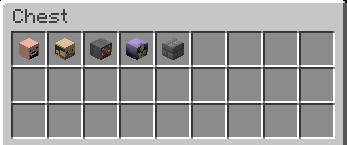
@Override
public void onInit(ViewConfigBuilder config) {
config.size(3);
}With user provided layout in the configuration
Respects the position specified by "O" character in the layout.
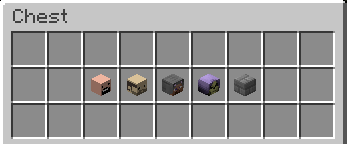
@Override
public void onInit(ViewConfigBuilder config) {
config.layout(
" ",
" OOOOO ",
" "
);
}Layouts are not used only in pagination so learn more about layouts on Wiki to do not get thing messy elsewhere as well!
Pagination exposes a specific type of state value called Pagination which is where the pagination data of a context is stored.
It contains several functions such as the number and index of the current page, next and previous pages, pagination data, navigation, etc. Dive into this to discover the possibilities of what to do with pagination for a context.
State<Pagination> pagination = paginationState.get(context);Navigation is no secret and there are some very explicitly named functions for it.
-
back()Backs to the previous page if available; -
advance()Advances to the next page if any; -
switchTo(n)Jumps to a specific page index.
In the example below we have "ARROW" for the "back to previous page" in the first slot and "forward to next page" in the last slot items.
@Override
public void onFirstRender(RenderContext render) {
Pagination pagination = paginationState.get(render);
// To back
render.firstSlot(new ItemStack(Material.ARROW))
.updateOnStateChange(paginationState)
.onClick(pagination::back);
// To advance
render.lastSlot(new ItemStack(Material.ARROW))
.updateOnStateChange(paginationState)
.onClick(pagination::advance);
}"What if I don't want to display the navigation items if there are no pages to navigate?"
For this you can use displayIf(BooleanSupplier) which was learned in the Basic Usage on Wiki.
@Override
public void onFirstRender(RenderContext render) {
Pagination pagination = paginationState.get(render);
// To back
render.firstSlot(new ItemStack(Material.ARROW))
.updateOnStateChange(paginationState)
.displayIf(pagination::canBack)
.onClick(pagination::back);
// To advance
render.lastSlot(new ItemStack(Material.ARROW))
.updateOnStateChange(paginationState)
.displayIf(pagination::canAdvance)
.onClick(pagination::advance);
}Handling of page switching is something little used so it is not accessible directly in the quick function paginationState, it will be necessary to use the advanced pagination builder for that buildPaginationState.
private final State<Pagination> paginationState = buildPaginationState(...)
.onPageSwitch((context, pagination) -> {
// ... do something on page switch ...
})
.build();As stated in the Introduction, pagination is a component and as it is possible to have multiple components in the view you can have multiple paginations as well. You just need to define the target layout character for each pagination.
In the example of this topic, we will render two paginations side by side, the one on the left side as "L" and the one on the right side as "R".
private final State<Pagination> leftPaginationState = buildPaginationState(...)
.layoutTarget('L')
.itemFactory((item, value) -> item.withItem(new ItemStack(Material.GOLD_INGOT)))
.build();
private final State<Pagination> rightPaginationState = buildPaginationState(...)
.layoutTarget('R')
.itemFactory((item, value) -> item.withItem(new ItemStack(Material.IRON_INGOT)))
.build();And then just create a layout that contains both "L" and "R" characters
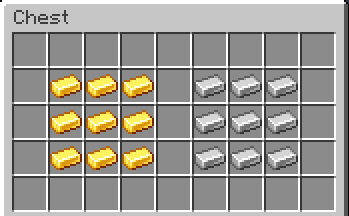
@Override
public void onInit(ViewConfigBuilder config) {
config.layout(
" ",
" LLL RRR ",
" LLL RRR ",
" LLL RRR ",
" "
);
}Navigation is done in the same way as normal pagination, add an item to it and navigate as usual.
@Override
public void onFirstRender(RenderContext render) {
Pagination leftPagination = leftPaginationState.get(render);
Pagination rightPagination = rightPaginationState.get(render);
// Manipulate "L" pagination navigation
render.slot(...).updateOnStateChange(leftPaginationState).onClick(leftPagination::back)
render.slot(...).updateOnStateChange(leftPaginationState).onClick(leftPagination::advance)
// Manipulate "R" pagination navigation
render.slot(...).updateOnStateChange(rightPaginationState).onClick(rightPagination::back)
render.slot(...).updateOnStateChange(rightPaginationState).onClick(rightPagination::advance)
}